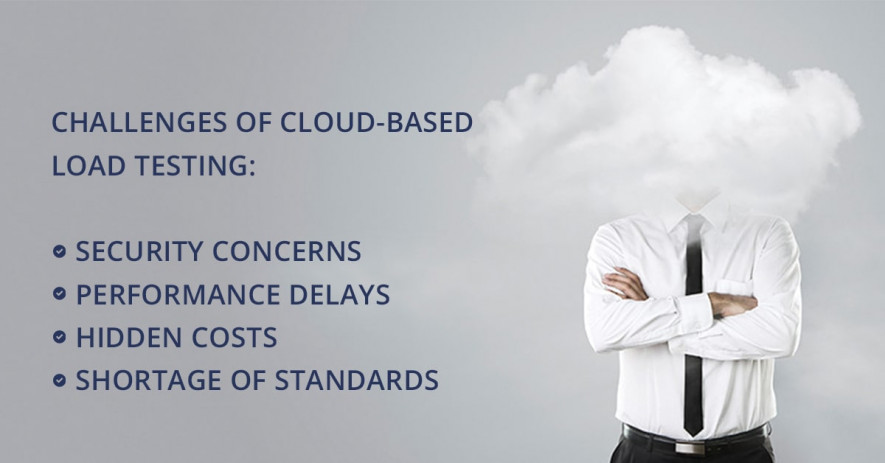Cloud-based Load Testing: Does it go Up or Down?
by Kate Libbie | December 3, 2019 10:07 am
Hardware days are over, cloud computing is a new black! At least, today’s hype makes us believe so. Due to the number of sweet promises, companies are quickly moving towards adopting this approach for performing load testing tasks. But, the practice also has shown a significant number of possible pitfalls and challenges. So, whom to believe? Keep reading this post with useful advice from QATestLab specialists to know the answer.
Why Companies Choose Load Testing in a Cloud?
Just look at this funny moment from Calvin and Hobbes cartoon. Of course, this explanation is far away from testing the real-world bridges. Though it would be fun to watch, isn’t it? Nevertheless, this could possibly best demonstrate how traditional load testing[1] services work, and this subject we will discuss today closer.

Overall, traditional load testing is when you emulate the biggest possible traffic and reproduce real-life scenarios needed for your software. You get the opportunity for measuring the response time and detecting potential malfunctions until the project will face a real load. In such a way you can easily evaluate how will your application work.
Unfortunately, as a practice has shown, this approach often falls short for Agile and DevOps. It is too expensive and requires lots of execution time. Sure thing, you can organize this process in a local mode using your server equipment. But what about choosing a cloud solution?

Since this technique doesn’t require installing any gadgets locally, it lets you create heavy loads and significantly save time and cost. Integrating the cloud into your testing process, you can run tests both from nodes without any geographical limits and wavered over time as well. As a result, you have all the chances to evaluate your test service scenarios quickly and effortlessly.
Cloud testing tools[2] are heading to transform old methods once and for all. Does it mean traditional load testing is dead? Although this statement may sound too bold, there’s some truth in that. A cloud-based paradigm gives QA specialists access to, literally, the entire world. Becoming a backbone in any IT director’s arsenal, numerous companies choose this type of testing and here are some key reasons for this:
- Easy-to-use. For traveling a testing procedure in a cloud load you need nothing else than setting up a few details or write a script like the JMeter, and then the real magic begins. Compared to traditional ways, this is a much easier procedure.
- More realistic workflows. This type of testing simulates a realistic load by letting virtual users run through all range of processes. It is practically impossible to get similar results through any other way of testing. A distinctive feature here is the opportunity to test the entire delivery chain, including even outermost firewalls and load balancers.
- Saving time and reducing costs. Cloud-based testing kills two birds with one stone. Working in a cloud, you can make your loads travel through all of the network layers and assess system behavior with a simple click of the mouse. No additional costs and no additional time! You can test everything and anytime, and pay only for what you use.
- Worldwide readiness. Another advantage of using cloud architecture is the absolute absence of geographical limitations. You can mimic user load from numerous locations around the globe. Just a few clicks to swiftly deploying your project and testing it anywhere. It sounds like a significant step forward in comparison with other approaches, doesn’t it?
- Clear customization. The QA team[3] can pick to segment the nodes and bundle them into groups. Cloud load testing allows switching the variables based on absolutely all needs, making it an incredibly practical method to test realistically.
As you can see, there are more than enough benefits you can reap of using cloud-based load testing. But don’t rush things out, this is only one side of a coin. Before making any conclusions it is worth looking through the list of shortcomings.
Polar Opinion: Is Cloud-Based Load Testing Service Dying?
Some companies have got enough experience with running load test service in a cloud and so consider this method has more disadvantages than advantages. Why do they think so? All that glitters is not gold and load testing in cloud architecture is not an exception. This approach is far away from being a hunky-dory solution to all problems due to several challenges:

Challenge #1 Security concerns
The privacy of data gotten from a user is a key milestone of the success of any business operation. But with the cloud paradigm, this factor leaves much to be desired. Although providers may offer guarantee privacy, here encoding methods pose a high risk of personal data leakage. Plus, there are all chances for your data to get outside your company’s storage.
Challenge #2 Performance delays
Another big problem with load testing in a cloud is a great possibility of delays in performance. After running the project, all your data can be shared and thus could lead to delays as well. Remember, even the smallest downtime can lead to negative consequences for your testing processes.
Challenge #3 Hidden costs
Working with a cloud, you are risking to have hidden costs. Is there any way out of this dilemma? Well, yes and no. Of course, you can carefully arrange your test settings. You can take into account additional charges like for data encryption, and carefully examine the use of cloud resources. Doing so will be good for you, but it’s not a total guarantee to avoid additional spendings.
Challenge #4 Shortage of standards
There are still no universal solutions for how testers can integrate the internal resources of their company’s data centers with public cloud resources. As public cloud providers develop their own architectures and working models, these cloud services have little interoperability. Thus, testers may encounter problems when changing cloud providers.
Conclusion on the Real State of Cloud-Based Load Testing
All-in-all, the cloud load testing paradigm is much more effective and convenient rather than a traditional one. A whole slew of companies is leaning towards adopting this big bang approach. But will it be selenium load testing[4] or any other process in a cloud, there are still some significant pitfalls you may encounter.
Security concerns, performance delays, hidden costs and shortage of standards – if you succeed in keeping your entire team informed about all these points, then there would be no reason to be scared of the word ‘cloud’. In all other cases, keep your feet on the ground and head out of the clouds!
What’s your opinion on this matter? Have you ever tried working with this approach? Feel free to share your experience in the comments section below. Don’t forget to subscribe to our blog[5] to see new posts.
Learn more from QATestLab
Related Posts:
- traditional load testing: https://qatestlab.com/resources/knowledge-center/stress-testing-implementation/
- Cloud testing tools: https://blog.qatestlab.com/2018/01/15/cloud-computing-trends/
- QA team: https://blog.qatestlab.com/2019/05/07/building-qa-team/
- selenium load testing: https://blog.qatestlab.com/2019/07/02/regression-testing-tools/
- blog: https://blog.qatestlab.com/
- Digitocracy: the state in a smartphone on the example of Ukraine: https://blog.qatestlab.com/2023/02/22/the-state-in-a-smartphone/
- Selenium Testing – The Bright and the Dark Sides: https://blog.qatestlab.com/2019/12/26/selenium-testing-characteristics/
- Performance Testing: 6 Best Practices: https://blog.qatestlab.com/2019/11/12/performance-testing-practices/
Source URL: https://blog.qatestlab.com/2019/12/03/cloud-based-testing/

